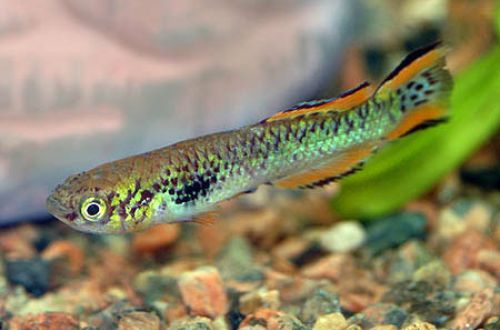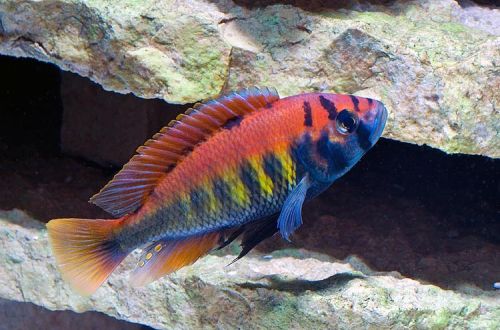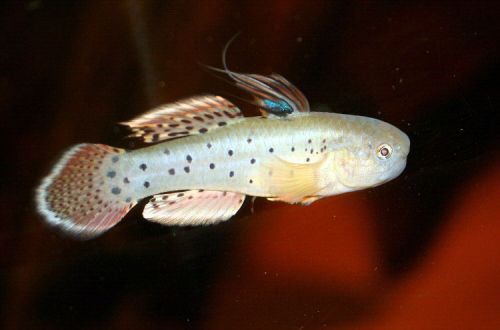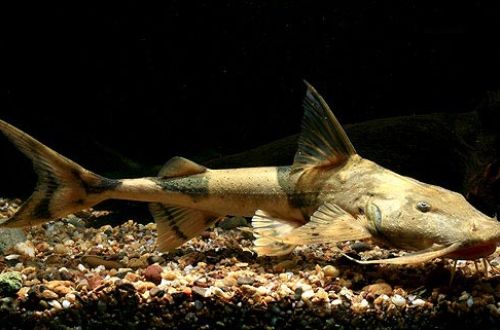
Afiosemion Valkera
Afiosemion Walkera, scientific name Fundulopanchax walkeri, belongs to the Nothobranchiidae family. A beautiful miniature, but not too friendly fish, by its nature it is a small predator, which, however, in a home aquarium will accept most popular foods, if they contain the necessary elements.

Contents
Habitat
It comes from the African continent from the territory of modern Ghana, Côte d’Ivoire. It lives in small streams, lakes and swamps located in the coastal strip, among tropical forests and savannahs.
Brief information:
- The volume of the aquarium – from 40 liters.
- Temperature – 20-23°C
- Value pH — 6.0–7.0
- Water hardness – soft (5-12 dGH)
- Substrate type – any dark
- Lighting – subdued
- Brackish water – no
- Water movement is weak
- The size of the fish is up to 6 cm.
- Meals – mostly meat
- Temperament – inhospitable
- Keeping a group in the ratio of one male and 3–4 females
Description
Adults reach a length of up to 5-6 cm. Males have a bright bluish color with red dots on the sides of the body and yellow fins. Females are noticeably more modestly colored, have a grayish color with transparent fins, and characteristic specks are often present in the pattern.
Food
Carnivorous species, preferring live or frozen foods such as daphnia, bloodworms and brine shrimp. On occasion, it can eat fry or a very small fish that can fit in its mouth. The daily diet may consist of specialized dry food containing protein and other proteins of animal origin necessary for the normal development of fish.
Maintenance and care, arrangement of the aquarium
A group of 3-4 fish will feel great in a tank of 40 liters or more. The design uses a dark substrate, areas with dense vegetation and snags for shelter. Floating plants are also welcome, they diffuse light and serve as a means of shading.
In the process of arranging an aquarium, the following features of this species should be taken into account: Afiosemion Valker reacts poorly to excessive movement of water, is prone to jumping out and prefers lower temperatures than other related Killy fish.
Behavior and Compatibility
A fairly aggressive fish for its size, it will attack smaller aquarium neighbors. It is able to get along only with peaceful large species, which, in turn, will not perceive it as a potential prey. The best option is to keep it in a species aquarium in the ratio of 1 male to 3-4 females.
Breeding / breeding
In favorable conditions, the appearance of offspring is very likely. The mating season lasts a couple of weeks, during which 10 to 30 eggs will be laid daily. Spawning usually takes place among stunted plants or mosses. Eggs should be immediately moved to a separate tank with identical water conditions, otherwise they will be eaten. The incubation period lasts up to 3 weeks. Fry should be kept at a very low water level, which is gradually increased as they grow.
It is worth noting that the eggs are prone to the formation of white plaque – this is a fungus, if measures are not taken in time, the entire masonry may die.
Fish diseases
Health problems arise only in case of injuries or when kept in unsuitable conditions, which depresses the immune system and, as a result, provokes the occurrence of any disease. In the event of the appearance of the first symptoms, first of all, it is necessary to check the water for the excess of certain indicators or the presence of dangerous concentrations of toxic substances (nitrites, nitrates, ammonium, etc.). If deviations are found, bring all values back to normal and only then proceed with treatment. Read more about symptoms and treatments in the Aquarium Fish Diseases section.





